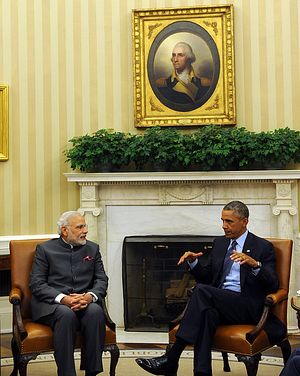Indian Prime Minister Narendra Modi has once again demonstrated why he remains one of the most interesting politicians in the country. By inviting the U.S. president, Barack Obama, to next year’s Republic Day celebrations, he has stumped his critics and surprised even his supporters. Last week, he informed the nation of his decision in a tweet, “This Republic Day, we hope to have a friend over… invited President Obama to be the 1st US president to grace the occasion as chief guest.” The White House was quick to accept the invite, underscoring the importance Washington attaches to restoring dynamism in U.S.-India relations and the confidence it has in the ability of Modi to deliver. “At the invitation of Prime Minister Modi, the President will travel to India in January 2015 to participate in the Indian Republic Day celebration in New Delhi as the Chief Guest,” a statement by the White House read minutes after the Modi tweet. With this visit, Obama will become the only U.S. president to visit India twice during his term in office.
Modi’s move is remarkable for many reasons. Most striking is the sheer audacity with which Modi seems to be challenging the foreign policy shibboleths of the past. On the surface, an invite for the U.S. President is not really significant. After all, the U.S. is now one of the closest partners of India. Be it the economy, defense, regional security, or geopolitics, there is today an extraordinary degree of convergence between the interests of the two states. Yet the diffidence of the Congress led-United Progressive Alliance government in acknowledging this openly was a reflection of the outmoded ideological trappings of the past. Even as former Prime Minister Manmohan Singh was gung-ho about a robust U.S.-India relationship, his party made sure that in the last four years, ties with the U.S. were not only put on the backburner but deliberate efforts were made to scuttle forward movement on issues which were clearly in India’s interest.
And now Prime Minister Modi in just a few months has brought about a paradigm shift in the relationship despite having being denied a visa by the U.S. in the past. In his very first month, his government scuttled the World Trade Organization’s Trade Facilitation Agreement (TFA) talks, leading to much talk of India’s impending global isolation. Yet New Delhi held onto its negotiating position and ultimately ended up signing a pact with the U.S. on the sidelines of the East Asia Summit in Nay Pyi Daw, which indefinitely extends the so-called “peace clause” in the TFA. India’s food procurement and subsidy program now cannot be challenged in any forum until a conclusive deal on the subject is concluded on the issue. Obama commended the “personal leadership” of Modi in finding a way forward to break the impasse. Here was a leader who was not merely obstructionist but was eager to find ways to move forward.
It was a clear diplomatic win for India but the prime minister decided to take U.S.-India ties a notch higher by inviting Obama to the 2015 Republic Day celebrations – an invite that is usually viewed as a celebration of India’s close diplomatic partnerships. This will be the first time a U.S. leader will grace India’s Republic Day celebrations as a chief guest. How ironic when one realizes that China and Pakistan have been part of these celebrations in the past but not the oldest democracy in the world. The Congress Party would never have been able to accomplish such a feat. The non-alignment ayatollahs in India must be scrambling at the diplomatic successes of the prime minister. For years, the nation has been told that the only way Indian foreign policy establishment can secure Indian interests is by working within the rubric of non-alignment. Just two years back, some of the best and the brightest in the Indian foreign policy establishment came up with a “new” foreign policy strategy for India. And lo and behold, they titled it “Non-Alignment 2.0.”
And now we have a prime minister and a government that is not trapped in the ideological moorings of the past. The Modi government is re-shaping Indian foreign policy in some fundamental ways. A self-assured Modi and his team have given up the defensiveness of the past. India is now confidently engaging with all major powers to secure the best possible outcomes for itself. Where in the name of non-alignment previous governments would not acknowledge its convergence with key partners, Modi and his government are explicit about affirming India’s key partnerships. The coyness of the past is giving way to a new refreshing openness, which is embedded in the pragmatic instincts of the prime minister. So the U.S.-India joint statement signed during the visit of Modi to Washington was explicit about the U.S.-India convergence in maintaining stability in South China Sea. It didn’t matter if the Chinese get annoyed. And after 28 long years, India reaches out to Australia at the highest levels to underscore Australia’s importance as a strategic partner of priority. Israel’s keenness to have an open relationship with India is too being reciprocated.
With his latest invite to Obama, Modi is signaling that the senseless anti-Americanism of the Indian polity is a thing of the past and there is every likelihood that Obama’s visit to India could be transformative. Modi has been consistently springing up surprises on the foreign policy front and is not afraid to take risks. It is remarkable that in just eight months into office, Modi will have hosted the U.S. president, the Russian president, and the Chinese president. Not a bad start for a politician who was considered by his opponents as a provincial leader before his electoral victory! And not bad for a government which has not uttered the word non-alignment even once since assuming office!

































